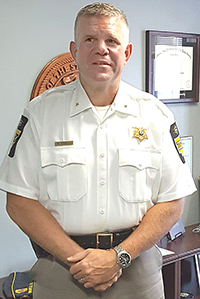BY BILL KNIGHT

Sheriff Brian Asbell (Photo by Bill Knight)
Many people worry about crime; they assume there’s cause. But much of that concern is an example of belief versus reality.
That disconnect faces 44-year-old Brian Asbell as he starts his position as Peoria County’s new sheriff after Mike McCoy resigned in June to become police chief in Washington, Ill.
Since McCoy left, Asbell served as interim sheriff for five weeks before a three-man Peoria County Board committee unanimously picked him to complete McCoy’s term. The County Board confirmed Asbell Aug. 10. He will serve through November 2018.
Now in charge of about 175 employees and dozens of additional contract workers, support personnel and volunteers all serving more than 180,000 people in an area of 629 square miles with 1,200 miles of roads, Asbell has several formidable tests to his leadership: budgeting, community relations, serving the mental-health needs of the jail population and coping with crime.
Between 1990-2015, U.S. violent crimes declined 37 percent, with the per-capita violent crime rate down 51 percent, reported Roger Smith in the Washington Spectator, a monthly independent political periodical with a circulation of 60,000.
“Murders over this period are down 37 percent in absolute terms, with the murder rate exactly half what it was 25 years ago,” Smith wrote, citing federal data. “Property crime is down by similar proportions.”
He questions why 60 percent to 84 percent of people responding to 30 years of annual surveys consistently indicate they believe crime is higher than a year ago.
Indeed, despite some statistics – plus a sense that the country has a new, sour mood of uncivility and hate – there’s no crime wave in Peoria, Asbell told Community Word, adding that most crimes are still tied to poverty and drugs.
The FBI’s most recent Uniform Crime Report has statistics for the City of Peoria that show an increase in violent crime from 2015 to 2016 but declines in property crimes. That’s not ideal, of course, but the numbers are better than Chicago and Rockford. For example, Peoria had about 325 violent crimes per 100,000 city residents, compared to 503 per 100,000 in Chicago and 836 per 100,000 in Rockford.
Further, just as Peoria “growth corridors” north on Ill. Route 40 and west on U.S. Route 150 aren’t immune from crime, the whole area should be considered in a look at the absence of crime, Asbell says.
“I’m looking at the county across the board,” he says. “I don’t see any spike in crime.”
County crime data from 2015 through the first half of 2017 show fluctuations in both property crimes and crimes against people. In the former, burglary of motor vehicles and of residences, theft, auto theft and arson all are trending down this year from 2016, when they increased. In the latter, battery and criminal sexual assault likewise show improvements from a rise from 2015 to 2016.
That’s similar to national figures, according to a 2017 Pew Research report, which shows violent crime in the United States has fallen sharply over the past quarter century, and property crime has declined significantly over the long term, but public perceptions often don’t align with the facts.
“In 2010 the jail had an average of 550 detainees. Now we have about 350,” Asbell says, conceding that other factors such as fewer officers, prosecutor choices and programs like “Don’t Shoot” could affect the numbers.
“Apart from that, jail population is a very good indicator of crime in the area,” adds Asbell, who started as a Peoria corrections officer in 1995, rising through the ranks as jail sergeant, patrol division, detective, then an undersheriff starting in 2009, when he became jail superintendent.
Pew’s John Gramlich says, “The FBI notes that various factors might influence a particular area’s crime rate, including its population density and economic conditions.”
Asbell agrees.
“In Peoria, crime has a lot to do with poverty,” he says. “It can become a ‘crime of survival.’ If someone can’t find gainful employment – especially ex-offenders – they’ll go back to what they know: shoplifting, stealing scrap, slinging drugs.
“We’re working with a faith-based group, ‘Jobs Partnership,’ a weeks-long character education employment program,” he continues. “It teaches basics; a lot of detainees never had this. If they’re trained in how to apply for a job, how to dress and be dependable and so on, it changes their self-worth.”
The opioid plague contributes.
“It’s an epidemic,” he says. “Addiction is a disease, and addicts need money to feed their addictions. Law enforcement must go on the offensive. We have to go out to schools, talk to parents, whatever it takes. These are deadly substances, and for people predisposed to addiction, one experience might instantly addict them, and it affects everyone around them.”
Addiction is a behavioral problem that burdens law enforcement, too, Asbell says.
“We’re one of the area’s biggest mental-health providers,” he says. “We’ve become a dumping ground for people who need help.”
For years, McCoy noted that 90 percent of jail detainees needed addiction or mental-health treatment, and Asbell helped get the Peoria County Jail’s medical unit accredited by the National Commission on Correctional Health Care in 2012. To achieve its recognition that Peoria uses the best practices, not just minimal requirements. The jail under Asbell’s watch started comprehensive screening for mental illness among new detainee.
Asbell says he’ll try to focus on causes, whether preventing crime or treating detainees.
“We’re working on a grant [application] now to help discharge planning, like hospitals do,” he says. “It’s a navigator for at-risk populations to help them with pharmaceuticals and medical appointments, housing and jobs.”
Despite such efforts and reassurance, some will be concerned.
As Tulane University’s Christopher J. Fettweis, who wrote “Dangerous Times” and “The Pathologies of Power,” said, “Our fear is not based on an intellectual conclusion. It’s a belief.”
And beliefs or feelings need few facts. In some ways, human beings embrace that which reinforces our opinions; we believe what we want to believe.

Recent Comments